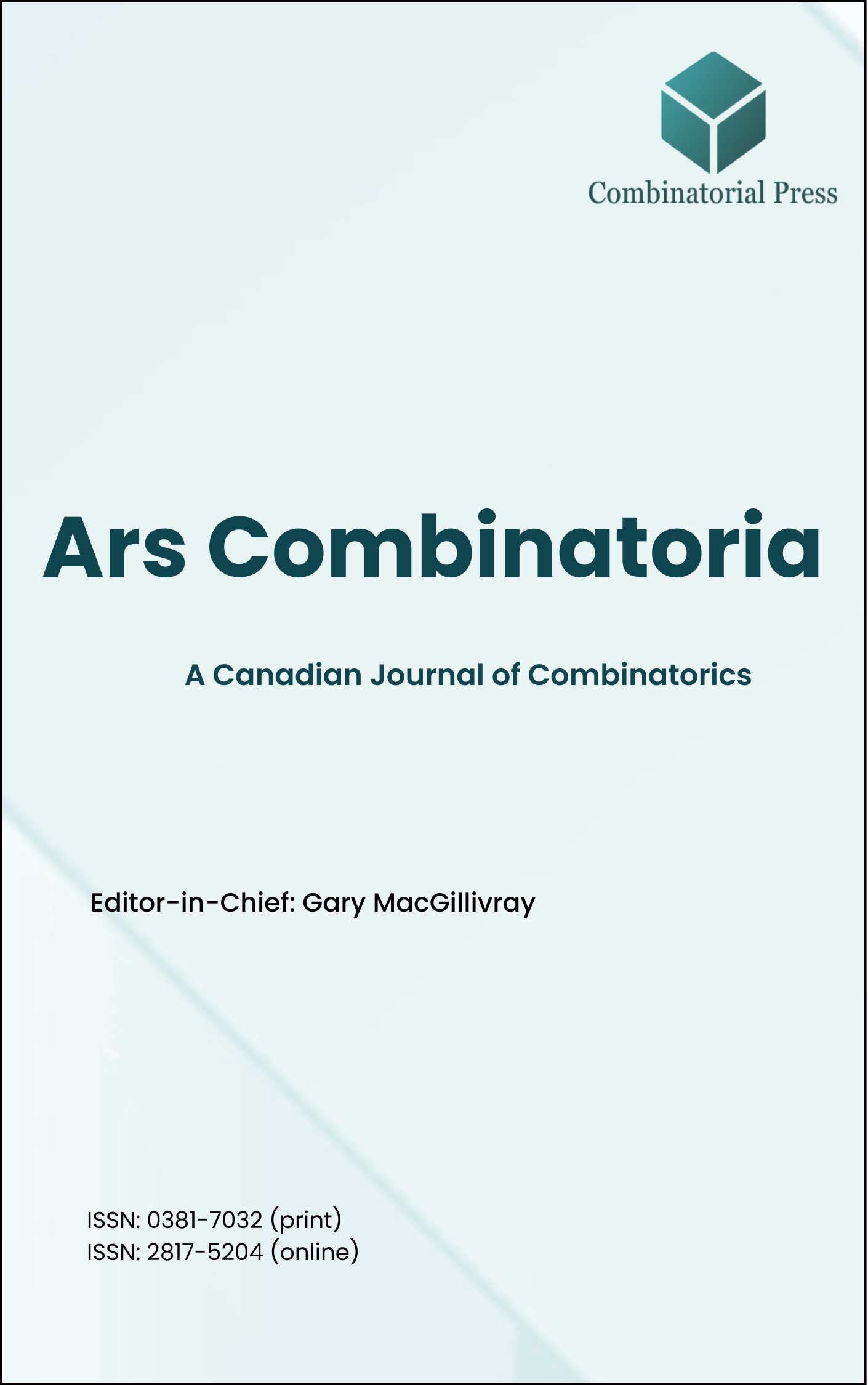
Ars Combinatoria
ISSN 0381-7032 (print), 2817-5204 (online)
Ars Combinatoria is the oldest Canadian Journal of Combinatorics, established in 1976. The journal is dedicated to advancing the field of combinatorial mathematics through the publication of high-quality research papers. From 2024 onward, it publishes four volumes per year in March, June, September and December. Ars Combinatoria has gained recognition and visibility in the academic community and is indexed in renowned databases such as MathSciNet, Zentralblatt, and Scopus. The Scope of the journal includes Graph theory, Design theory, Extremal combinatorics, Enumeration, Algebraic combinatorics, Combinatorial optimization, Ramsey theory, Automorphism groups, Coding theory, Finite geometries, Chemical graph theory but not limited.
Information Menu
- Research article
- Full Text
- Ars Combinatoria
- Volume 039
- Pages: 211-229
- Published: 30/04/1995
A map is an embedding of a graph into a surface so that each face is simply connected. Geometric duality, whereby vertices and faces are reversed, is a classic construction for maps. A generalization of map duality is given and discussed both graph and group theoretically.
- Research article
- Full Text
- Ars Combinatoria
- Volume 039
- Pages: 189-198
- Published: 30/04/1995
We show how a claw-free well-covered graph containing no \(4\)-cycle, with any given independence number \(m\), can be constructed by linking together \(m\) sub-graphs, each isomorphic to either \(K_2\) or \(K_3\). We show further that the only well-covered connected claw-free graphs containing no \(4\)-cycle that cannot be constructed in this way are \(K_1\), and the cycle graphs on \(5\) and \(7\) vertices respectively.
- Research article
- Full Text
- Ars Combinatoria
- Volume 039
- Pages: 183-188
- Published: 30/04/1995
In [3] R. Brauer asked the question: When is an \(n \times n\) complex matrix \(X\) the ordinary character table of some finite group? It is shown that the problem can be reduced in polynomial time to that of VERTEX INDEPENDENCE. We also pose and solve some (much) simpler problems of a related combinatorial nature.
- Research article
- Full Text
- Ars Combinatoria
- Volume 039
- Pages: 175-181
- Published: 30/04/1995
Let \(\mathbb{F}_q = \text{GF}(q^n)\) denote the finite field of order \(q^n\), and let \(U_n = \cup_{i=1}^{n}(\mathbb{F}_i,)\). Explicit permutation-type formulas for the Frobenius map \(\varphi\) (defined by \((\varphi(x)) = x^q\)) on \(\mathbb{F}_n\) and on \(U_n\) are obtained by using the well-known number \(N_q\) (the number of monic irreducible polynomials of degree \(i\) in \(\mathbb{F}_1[x]\)). Some results in [1] and [2] can be obtained from these formulas. Moreover, some other results are also given by using Pólya’s counting theory.
- Research article
- Full Text
- Ars Combinatoria
- Volume 039
- Pages: 167-173
- Published: 30/04/1995
The composition of two graphs \(G\) and \(H\), written \(G[H]\), is the graph with vertex set \(V(G) \times V(H)\) and \((u_1,v_1)\) is adjacent to \((u_2,v_2)\) if \(u_1\) is adjacent to \(u_2\) in \(G\) or if \(u_1 = u_2\) and \(v_1\) is adjacent to \(v_2\) in \(H\). The \(r\)th power of graph \(G\), denoted \(G^r\), is the graph with vertex set \(V(G)\) and edge set \(\{(u,v) : d(u,v) \leq r \text{ in } G\}\). The bandwidth of graph \(G\) is \(\min \max |f(u) – f(v)|\), where the max is taken over each edge \(uv \in E(G)\), and the min is over all proper numberings \(f\). This paper establishes tight upper and lower bounds for the bandwidth of an arbitrary graph composition \(G[H]\), with the upper bound based only on \(|V(H)|\) and the bandwidth of \(G\). In addition, the exact bandwidth of the composition of \(G[H]\) is established for \(G\) the power of a path or a cycle.
- Research article
- Full Text
- Ars Combinatoria
- Volume 039
- Pages: 161-165
- Published: 30/04/1995
- Research article
- Full Text
- Ars Combinatoria
- Volume 039
- Pages: 199-210
- Published: 30/04/1995
The edge-neighbor-connectivity of a graph \(G\) is the minimum size of all edge-cut-strategies of \(G\), where an edge-cut-strategy consists of a set of common edges of double stars whose removal disconnects the graph \(G\) or leaves a single vertex or \(\emptyset\). This paper discusses the extreme values of the edge-neighbor-connectivity of graphs relative to the connectivity, \(\kappa\), and gives two classes of graphs — one class with minimum edge-neighbor-connectivity, and the other one with maximum edge-neighbor-connectivity.
- Research article
- Full Text
- Ars Combinatoria
- Volume 039
- Pages: 155-160
- Published: 30/04/1995
In \([V_2]\), Vince outlined three potential graph algorithms for \(S^3\) recognition, namely shelling, reducing, and closing; on the other hand, he conjectured that the graph \(H_0\ ) of Fig.1 – which proves the first two to fail – could be a counterexample for the third one, too. This note shows that the conjecture is false; so, the validity of the closing algorithm is still an open problem.
- Research article
- Full Text
- Ars Combinatoria
- Volume 039
- Pages: 149-154
- Published: 30/04/1995
We consider two variations of the classical Ramsey number. In particular, we seek the number of vertices necessary to force the existence of an induced regular subgraph on a prescribed number of vertices.
- Research article
- Full Text
- Ars Combinatoria
- Volume 039
- Pages: 139-148
- Published: 30/04/1995





